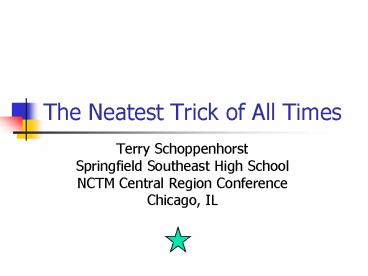The Neatest Trick of All Times - PowerPoint PPT Presentation
1 / 29
Title:
The Neatest Trick of All Times
Description:
How to Set Up the Trick. Choose a suit. Choose a (or the) suit that is ... The same steps as the original using the new permutation table. Time to Practice Again ... – PowerPoint PPT presentation
Number of Views:37
Avg rating:3.0/5.0
Title: The Neatest Trick of All Times
1
The Neatest Trick of All Times
- Terry Schoppenhorst
- Springfield Southeast High School
- NCTM Central Region Conference
- Chicago, IL
2
How to Set Up the Trick
3
Choose a suit
- Choose a (or the) suit that is repeated.
- This will become the key suit and will ultimately
be the suit of the hidden card.
- By choosing five cards, you are guaranteed to get
at least one of them to repeat. - Pigeonhole Principle.
4
Choose which card to hide
- Consider the sequence ace through king.
- When you reach the king, start the sequence over.
- Pick the card that is, at a maximum, 6 steps
above the card of the same suit. - That card is hidden, while the other becomes the
key card.
5
Determine the order of the four remaining cards
- A 1
- 2 2
- 3 3
- etc.
- J 11
- Q 12
- K 13
- Add the values of the remaining cards. Call this
value t. - Find t mod 4.
- This will be the position of the key card
assuming we use position 0 to position 3.
6
Determine the order of the four remaining cards
(continued)
- Consider the sequence clubs, diamonds, hearts,
and spades (alphabetical order) - Ignoring the key card, rank the other cards
by suit into low, medium, and high.
- If there are duplicates within suits use the
ranking of ace through king. - LMH 1
- LHM 2
- MLH 3
- MHL 4
- HLM 5
- HML 6
- Permutations.
7
Determine the order of the four remaining cards
(continued)
- Place those three cards around the key card
in the appropriate order.
8
How to Guess the Hidden Card
9
Determine the key card
- Add up all visible cards using the numbering
system. Call this number t. - Find t mod 4.
- This will give you the position of the key
card. - Remember to count beginning with 0.
10
Determine how much to add to the key card
- Rank the three remaining cards using low, medium,
and high. - Add the amount to the key card.
- Remember to wrap around the king, if necessary.
11
State the answer
- Amaze all those looking on.
12
Time for Practice
13
Variations on the Original Trick
14
Suppose the Cohort Behaves Badly
15
Determine the hidden card
- Exactly the same as original trick.
16
Determine the location of the key card
- Determine the distance from the key card to
the hidden card. - If 1 3, put two of the remaining cards face
down. - If 4 6, put one of the remaining cards face
down.
- Using the visible cards, determine the location
of the key card in the same manner as before.
17
Determine the location of the three remaining
cards
- UDD 1
- DUD 2
- DDU 3
- DUU 4
- UDU 5
- UUD 6
- Permutations.
- Depending on the number of steps required to get
to the hidden card, place the cards in the
appropriate order around the key card.
18
Guess the hidden card
- The same steps as the original using the new
permutation table.
19
Time to Practice Again
20
Suppose the Cohort Behaves VERY Badly
21
Main differences
- Only three cards will be showing and not
necessarily all face-up. - If all of them are face down, the hidden card is
the king of spades.
- Supersuits are required
- Alpha ace of clubs to 4 of diamonds.
- Beta 5 of diamonds to 8 of hearts.
- Gamma all others.
22
Main differences (continued)
- The first card face up represents the supersuit
of the hidden card.
- UDD 1
- DUD 2
- DDU 3
- DUU 4
- UDU 5
- UUD 6
- UUU 7 or 8
- Permutations
23
Main differences (continued)
- If all three are face-up, the second and third
cards would be ranked. - LH 7
- HL 8
- Permutations
- Amaze onlookers even more.
24
Time to Practice Yet Again
25
Suppose the Audience Behaves Badly
26
Huge differences
- It is possible to allow the audience which card
to hide. - The mathematics is not as nice and requires both
the cohort and the performer to order every
single card of the entire deck.
27
References
- http//www.spelman.edu/colm/fitch.pdf
- http//people.brandeis.edu/kleber/Papers/card.pdf
- http//www.diophante.fr/pages/CardShaiSimonson.pdf
- http//www.maa.org/columns/colm/cardcolm200502.htm
l
28
Access to software and presentation
- http//www.springfield.k12.il.us/teachers/tschop
29
Questions































